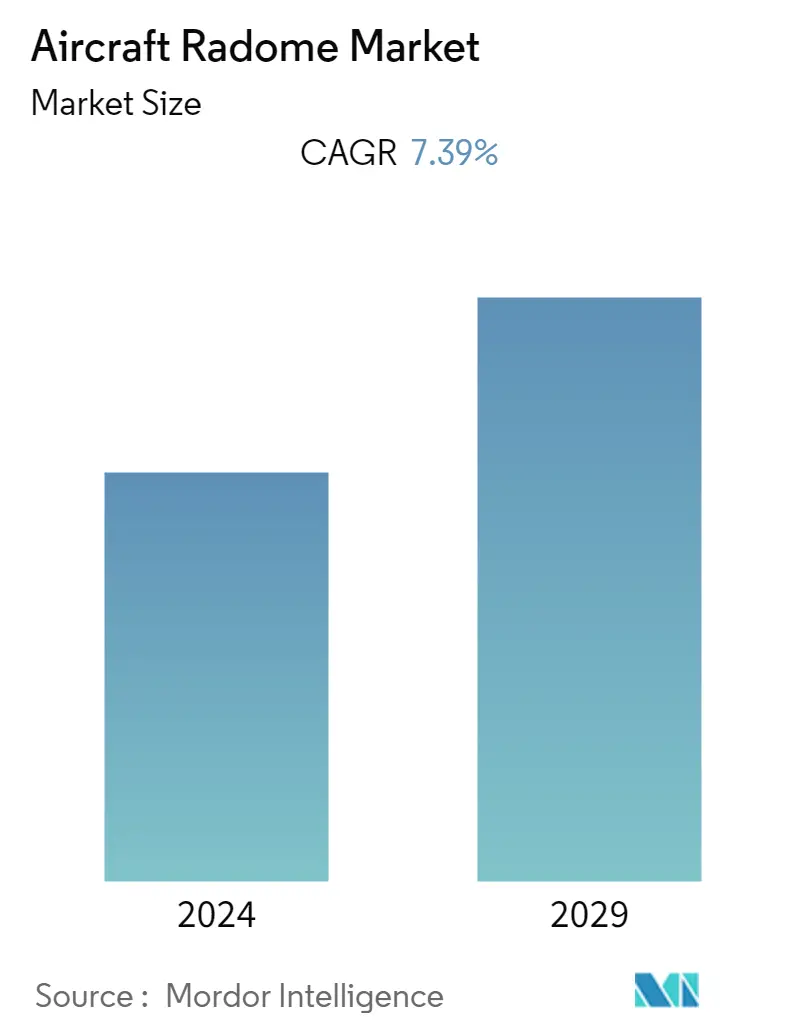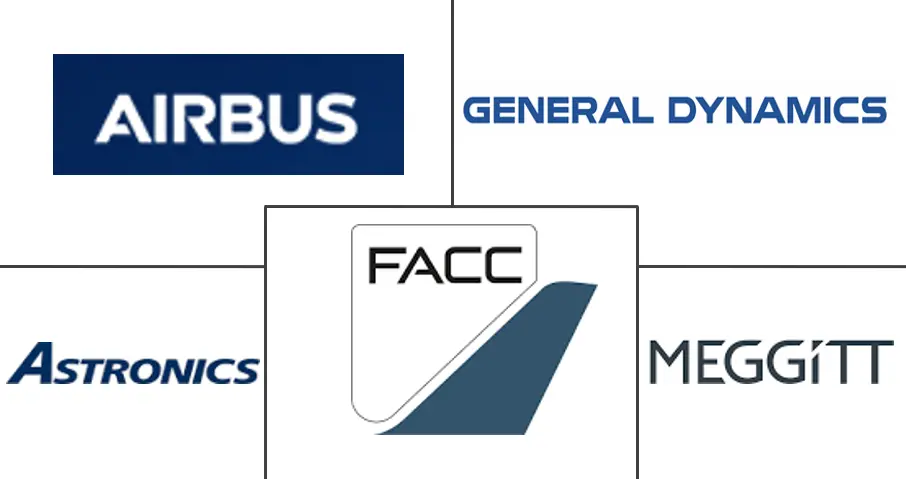Market Size of Aircraft Radome Industry

| Study Period | 2019 - 2029 |
| Base Year For Estimation | 2023 |
| Forecast Data Period | 2024 - 2029 |
| CAGR | 7.39 % |
| Fastest Growing Market | Asia Pacific |
| Largest Market | Asia Pacific |
Major Players
*Disclaimer: Major Players sorted in no particular order |
Aircraft Radome Market Analysis
The Aircraft Radome Market was valued at USD 475 million in 2020, and it is projected to reach USD 818 million by 2026, registering a CAGR of 7.39% during the forecast period (2021-2026).
There was a slump in demand for commercial aircraft in 2020 due to the COVID-19 pandemic. With the global passenger traffic estimated to take 2-3 years to fully recover, the demand for commercial aircraft is expected to be less in the first half of the forecast period, which is expected to hamper the demand for commercial aircraft radomes during the forecast period.
The demand for radomes from the business jets segment is expected to recover faster than the commercial aviation sector, as the business jet demand is projected to recover earlier as compared to the commercial aircraft. On the other hand, with the military aircraft demand showing resilience compared to the commercial and general aviation segments, the demand for radomes from the military segment showcased growth even in 2020.
With the demand for more efficient radomes, manufacturers are expected to invest in new materials for radomes. The demand for aircraft radome with quartz fiber is increasing from both the commercial and the military end-users across the globe. The development of newer generation AESA radars in military aircraft is also expected to drive the development of radomes with better capabilities.
Aircraft Radome Industry Segmentation
Radome serves as a structural enclosure that protects the radar system. The nose cones of an aircraft often serve as radomes, and they are constructed with specific materials, like fiberglass, quartz, honeycomb, and foam cores, that can protect sensitive instruments while allowing electronic signals to pass through. Radomes used on Helicopters and UAVs are excluded from the purview of the report. The aircraft radome market is segmented by application into commercial aircraft, military aircraft, and business jets. The report also offers the market size and forecasts for the aircraft radome market in major countries across all the regions. For each segment, the market size and forecasts are represented by value (USD million).
| Application | |
| Commercial Aircraft | |
| Military Aircraft | |
| Business Jets |
| Geography | |||||||
| |||||||
| |||||||
| |||||||
| |||||||
|
Aircraft Radome Market Size Summary
The aircraft radome market is poised for significant growth, driven by the increasing demand for both commercial and military aircraft. Despite a temporary setback in demand due to the COVID-19 pandemic, which affected the commercial aviation sector, the market is expected to recover as airlines modernize and expand their fleets. The business jet segment is anticipated to recover more swiftly, while the military aircraft sector has shown resilience, contributing to steady demand for radomes. Manufacturers are focusing on developing radomes with advanced materials, such as quartz fiber, to meet the evolving needs of both commercial and military end-users. The introduction of newer generation AESA radars in military aircraft is also expected to spur innovation and development in radome technology.
Regionally, Asia-Pacific is leading the market, with China and India emerging as significant players due to their robust aircraft procurement activities and growing air passenger traffic. The region's market is projected to experience the highest growth rate during the forecast period, driven by economic growth, military modernization, and increasing demand for business jets. The competitive landscape of the aircraft radome market is characterized by the presence of established aerospace manufacturers and the entry of new players, which is expected to enhance competition. Companies are focusing on innovation, competitive pricing, and the development of lightweight materials to secure long-term contracts with aircraft OEMs.
Aircraft Radome Market Size - Table of Contents
-
1. MARKET DYNAMICS
-
1.1 Market Overview
-
1.2 Market Drivers
-
1.3 Market Restraints
-
1.4 Industry Attractiveness - Porter's Five Forces Analysis
-
1.4.1 Threat of New Entrants
-
1.4.2 Bargaining Power of Buyers/Consumers
-
1.4.3 Bargaining Power of Suppliers
-
1.4.4 Threat of Substitute Products
-
1.4.5 Intensity of Competitive Rivalry
-
-
-
2. MARKET SEGMENTATION (Market Size by Value - USD million)
-
2.1 Application
-
2.1.1 Commercial Aircraft
-
2.1.2 Military Aircraft
-
2.1.3 Business Jets
-
-
2.2 Geography
-
2.2.1 North America
-
2.2.1.1 United States
-
2.2.1.2 Canada
-
-
2.2.2 Europe
-
2.2.2.1 United Kingdom
-
2.2.2.2 France
-
2.2.2.3 Germany
-
2.2.2.4 Rest of Europe
-
-
2.2.3 Asia-Pacific
-
2.2.3.1 China
-
2.2.3.2 India
-
2.2.3.3 Japan
-
2.2.3.4 South Korea
-
2.2.3.5 Rest of Asia-Pacific
-
-
2.2.4 Latin America
-
2.2.4.1 Brazil
-
2.2.4.2 Rest of Latin America
-
-
2.2.5 Middle-East and Africa
-
2.2.5.1 United Arab Emirates
-
2.2.5.2 Saudi Arabia
-
2.2.5.3 Israel
-
2.2.5.4 Rest of Middle-East and Africa
-
-
-
Aircraft Radome Market Size FAQs
What is the current Aircraft Radome Market size?
The Aircraft Radome Market is projected to register a CAGR of 7.39% during the forecast period (2024-2029)
Who are the key players in Aircraft Radome Market?
General Dynamics Mission Systems Inc., Astronics Corporation, Meggitt PLC, FACC AG and Airbus SE are the major companies operating in the Aircraft Radome Market.

